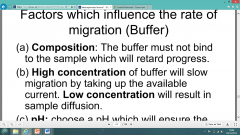![]()
![]()
![]()
Use LEFT and RIGHT arrow keys to navigate between flashcards;
Use UP and DOWN arrow keys to flip the card;
H to show hint;
A reads text to speech;
31 Cards in this Set
- Front
- Back
|
What are the 2 forces which act upon molecules during electrophoresis? |
Impelling and retarding forces.
|
|
|
What charge is on the cathode and what does it attract? |
Negative and it attracts cations. |
|
|
What charge is on the anode and what does it attract? |
Positive and it attracts anions. |
|
|
What is the equation for propelling force? |
(E x q) where E is field strength and q is net charge on the molecule. |
|
|
Electrophoresis of DNA and RNA is conducted using what? |
Agarose Gel. |
|
|
The movement of charged molecules in an electrical field is proportional to what? |
Field strength. |
|
|
The movement of charged molecules in an electrical field is inversely proportional to what? |
Size of the molecule and viscosity. |
|
|
Electrophoresis of proteins is conducted using what? |
Polymers of acrylamide. |
|
|
What does the extent of the negative charge (and therefore movement during electrophoresis) of a protein depend on? |
Amount of glutamate and aspartate residues in the proteins primary structure. |
|
|
How is the DNA viewed after moving during electrophoresis? |
A dye is added. |
|
|
What factors effect the retardation force of DNA and RNA in agarose gel? |
The size of the polymer (longer chains cause friction). |
|
|
What is the value of the y axis on an electrophoresis graph? |
The Log10 of the Kbp (kilobase pairs). |
|
|
What are the zone electrophoresis support materials? |
Paper, cellulose acetate, gel (acrylamide for proteins, agarose for DNA/RNA). |
|
|
What effect does low sample adsorption have? |
High resolution. |
|
|
What are the factors related to the buffer which influence the rate of migration?
|
Composition, [low], [high], p H.
|
|
|
What are the specifics of the buffer - migration relationship? |

|
|
|
What are the problems with the support in zone electrophoresis? |
Adsorption: sample leaks through point of entry causing trailing, Molecular sieving: Large molecules cannot fit through the pores in the gel, Electroendosmosis: Negative groups on cellulose acetate attract H3O+, which retards the flow of anions to the cathode. |
|
|
In which type of PAGE do polypeptides move through the porous acrylamide network according to their size? |
Denaturing PAGE. |
|
|
Which type of PAGE separates proteins on their charge and mass? |
Non denaturing PAGE. |
|
|
What temperature to proteins denature? |
40C |
|
|
In zone electrophoresis, what are the initiators and catalyst that are mixed with monomers of acrylamide to initiate polymerisation? |
Ammonium sulphate and TEMED. |
|
|
What are the advantages of using PAGE? |
1. Polyacrylamide is extremely reproducible under standard conditions 2. Pore size can be easily varied, by altering polyacrylamide concentration. |
|
|
What does 'PAGE' stand for? |
Polyacrylamide gel electrophoresis. |
|
|
What size pore does acrylamide with 10% monomer concentration (%T) produce? |
2.6nm |
|
|
When %T of acrylamide monomer is 10%, proteins of what Mr are able to be separated? |
Mr between 10,000 and 100,000. |
|
|
Which molecules migrate faster during denaturing PAGE? |
Smaller molecules (due to less frictional resistance). |
|
|
What is the reducing agent required in denaturing PAGE? |
2-mercaptoenthanol (2ME). |
|
|
What happens to most proteins in electrophoresis at pH 8.5? |
They have an overall negative charge, and move toward the anode. |
|
|
Which bonds in proteins are broken during denaturing PAGE? |
Hydrogen bonds, salt bridges and Van der Waals interactions. |
|
|
In denaturing PAGE, what is the rate of migration related to? |
Log10 Mr |
|
|
Which type of page separates proteins in the presence of a detergent, and removes secondary, tertiary and quaternary structure? |
Denaturing PAGE. |

